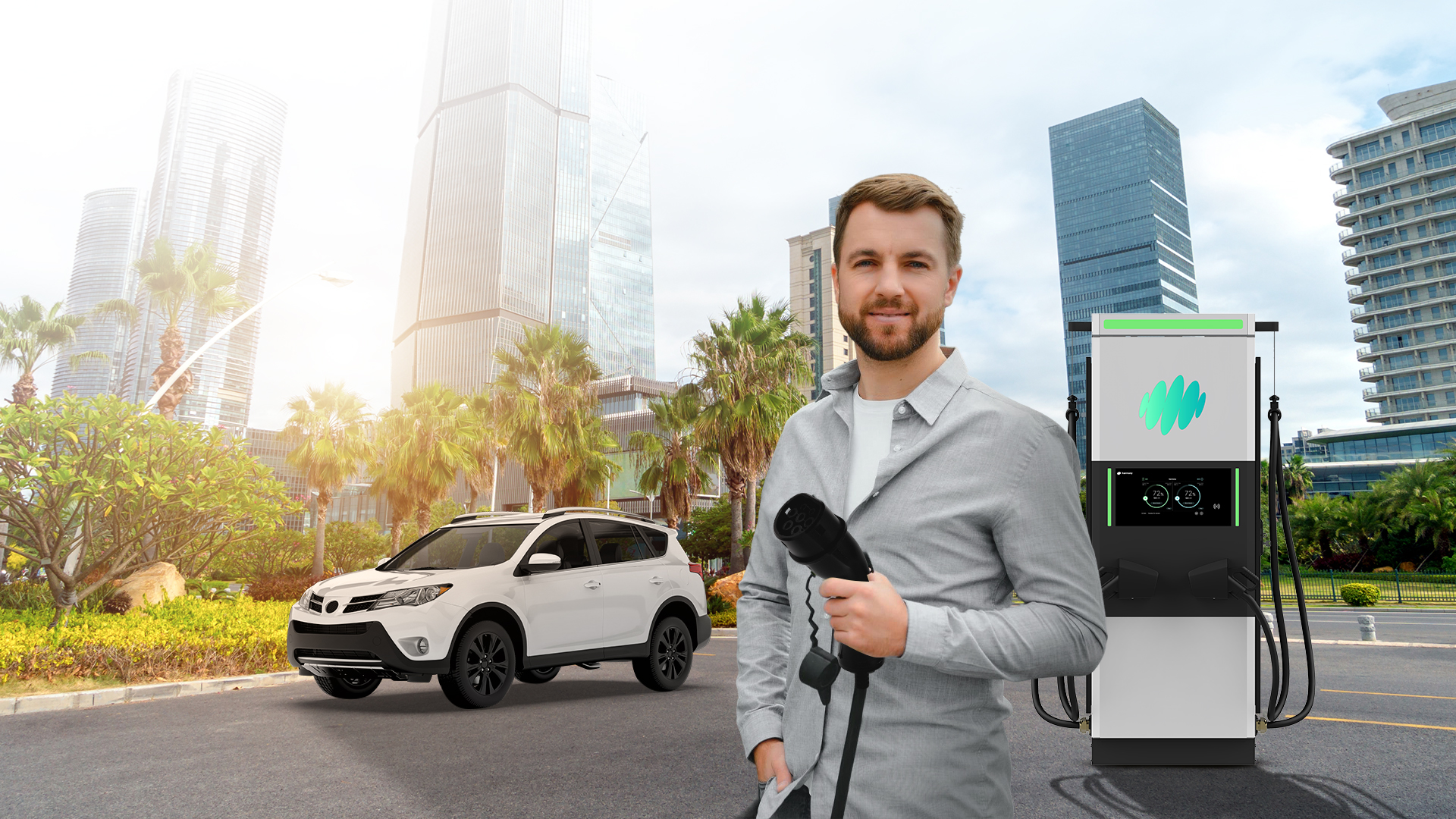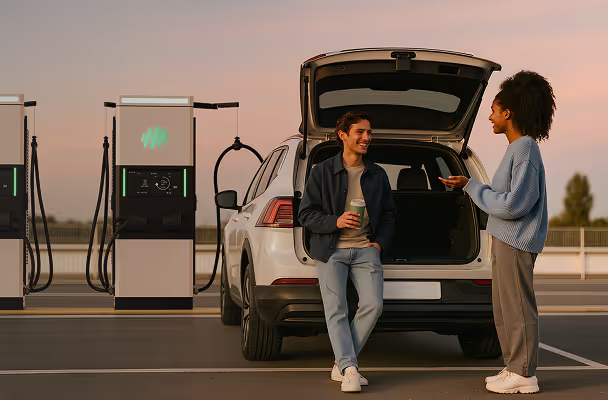Customer-Centric EV Solutions in DC Fast Charging

The last in the blog series will provide an overview of customer centricity in EV charging. We will discuss the importance of customer-centricity and suggest steps that CPOs can take to improve it.
India has registered 1.97 million EVs in the fiscal-year 2024-25. June 2025 alone saw a 28.6% surge in EV sales, driven by an almost 80% jump in electric passenger vehicle sales. According to International Energy Agency (IEA), India’s EV adoption rate rose from 0.7% of total vehicle sales in 2020 to over 6% in 2024, This is an explosive growth signaling a transition from early adopters to the mass market.
As highlighted in our previous blogs, this surge in EV adoption will demand exponential expansion in public EV charging infrastructure. Coupled with favorable government policies, this is the golden opportunity for charge point operators (CPOs) to take their EV charging stations to the next level.
CPOs should consider cost-per-unit AND value-per-experience
With a growing customer base, a CPO’s business prospects are huge. But like in any other business, it’s customer retention that shall decide the winner. Users expect a smart, intuitive, and frustration-free experience at an EV charging station. But this is often hindered by inconsistent charger availability, complicated sign-ups, and opaque pricing. We are looking at an impending wave of change. As more people consider switching to EVs, there are more expectations to be catered for.
To unlock the full potential of the EV market, CPOs must shift toward customer-centric DC fast charging solutions that address real-world friction points across the entire charging journey. Keeping pace with rising, diverse customer expectations is possible only by using the latest in customer experience technologies.
Key Customer-Centric Features That Drive Adoption and Loyalty
Here are the most important solutions that play an important role in improving the experience of drivers in an EV charging station.
1. Authentication process should adapt to user behavior
Many EV drivers today face “app overload”. Each charging network demands their own app, account, or RFID card. This complicated authentication is a major pain point. A truly customer-centric solution offers a simple sign up and authorization process.
What is even more interesting is that this authorization can also be flexible. A user should ideally be able to plug-in and authenticate, or authenticate and plug-in, as per their habits. When a user can drive up to any station and start charging in seconds, without fighting through multiple sign-ins or membership checks, it creates a frictionless experience that keeps them coming back.
2. Charging cables and guns should be easy to use for everyone
Public chargers often ignore physical usability. Some women, seniors, and disabled users may not be comfortable in handling cables that weigh as high as 15-20kg.
Mechanically aided cable retraction systems use counterbalanced arms or motorized reels, which reduces the effective lift weight by 40–60%. Sensor based plug–in sockets with display guides make docking easier. Plug height, display orientation, and reach radius standards are being introduced in newer BIS EVSE guidelines.
3. Charging Speed and payment details should be clearly communicated
EV drivers want instant clarity on how fast their vehicle will charge, how long it will take, and how much it will cost. Intuitive app interfaces that display charging power (kW), estimated time remaining, and session cost at one glance, provide a great improvement in user experience.
This is enabled through OCPP protocols, which allow chargers to send real-time session data to a CPO's backend and user-facing apps. Algorithms based on state-of-charge (SoC) prediction models provide time-to-full estimates with high accuracy. OCPP 2.0.1 also supports transaction event reporting that can be displayed to enhance payment journey.
4. Chargers must have high reliability and uptime
Nothing erodes trust faster than arriving at an EV charging station and finding non-functional chargers. Users need to trust that an EV charging session will be successful every time the vehicle is plugged in. If users frequently encounter offline units and error codes, they will avoid that network. High uptime and high reliability are thus very important to prioritize.
Charger uptime is maintained using remote monitoring systems, powered by SNMP (Simple Network Management Protocol) and predictive maintenance algorithms. These systems analyze telemetry like temperature, voltage fluctuations, and error logs to predict failures and trigger auto-tickets.
The number of successful charges can significantly improve upon making use of this proactive technology. Predictive analytics reduced charger downtime by 20-30% on average.
5. EV charger UI/UX should be inclusive
Multilingual UI/UX is a necessity in India’s EV charging ecosystem. India is a multilingual, diverse country. Many EVs on Indian roads are two-wheelers, three-wheelers, and fleets. These are often owned by drivers who do not have bilingual proficiency in English.
NITI Aayog’s EV infrastructure handbook underscores the need for standardized, multilingual UI/UX designs to ensure accessibility for all demographics, including rural and semi-urban users.
6. EV charging stations should be well-lit and secure
Safety concerns are a critical factor influencing the adoption and frequent use of EV charging stations.
A survey by McKinsey found that 28% of EV drivers avoid charging stations they perceive as 'unsafe' or 'poorly maintained', particularly after dark. This avoidance directly reduces station utilization and harms operator revenue.
Ambient lighting and visible security features, such as CCTV cameras not only enhance user comfort, but also reduce vandalism. This lowers maintenance costs and improves the reputation of the EV charging station.
7. EV drivers should be able to use idle charging time fruitfully
Integrating EV charging stations with local service ecosystems creates added value for customers. EV drivers value the availability of nearby amenities, where they can spend their free time as the vehicle charges. This factor influences their choice of charging station. An EV charging station with good food and shopping options has longer dwell times and higher spending rates. This benefits both CPOs and local businesses. Offering perks such as coffee discounts, convenience store offers, or loyalty points transforms the otherwise idle charging time into a positive, productive experience.
8. EV charging needs to be built around the customer, not Just the vehicle
India’s EV market is shifting from early adopters to the mass market. The center of gravity in EV charging is also moving from sheer infrastructure rollout, to delivering a superior customer experience. CPOs that delight users with clear information, fair pricing, effortless access, and rock-solid reliability – will not only attract more drivers, but also retain them for the long term.
This concludes our blog series on the 4 pillars of DCFC. For reading our previous blogs please refer:
FAQs:
Q: Why is customer-centricity important in EV charging solutions?
A: Customer-centric EV charging solutions improve satisfaction, loyalty, and station utilization, which are essential for mass EV adoption and business growth.
Q: How does multilingual UI/UX impact EV charging station usage?
A: In India, 35% of EV users report language barriers at charging stations. Multilingual UI/UX ensures accessibility for all, especially in regions with diverse languages.
Q: What role does safety play in EV charging station design?
Features like ambient lighting and CCTV increase user confidence. 28% of users avoid poorly lit or unsafe stations, reducing utilization.
Q: How do partnerships with nearby shops enhance the charging experience?
A: Amenities and discounts at nearby shops are valued by 40% of users, making charging time productive and increasing station preference.
Q: What technology improves charger reliability?
A: Predictive maintenance and remote monitoring can reduce downtime by up to 31%.
Bibliography
- Arthur D. Little, "Customer Experience Drives Value in Public EV Charging," 2024.
- IEA, "Global EV Outlook 2025."
- NITI Aayog, "Handbook for EV Charging Infrastructure Implementation," 2021.
- McKinsey & Company, "EV Fast Charging: How to Build and Sustain Competitive Differentiation," 2024.
- KPMG, "Electric Vehicle Charging: The Customer Experience Imperative," 2023.
- World Resources Institute (WRI) India, "EV User Survey on Charging Station Safety," 2024.
- ICCT, "India Synchronizes EV Sales and Charging Infrastructure Growth," 2025.
- Nature, "Electric Vehicles: The Road Ahead," 2024.
- Bain & Company, "EV Charging Infrastructure: Creating Value for Users and Operators," 2024.
- Tesla, "Charging Experience Insights," 2024.
- IEEE IoT Journal, "Predictive Analytics in EV Charging Networks," 2022.
- PM E-DRIVE Scheme, Ministry of Power, Government of India, 2025.
Frequently Asked Questions
Lorem ipsum dolor sit amet, consectetur adipiscing elit, sed do eiusmod tempor incididunt ut labore et dolore magna aliqua. Ut enim ad minim veniam, quis nostrud exercitation ullamco laboris nisi ut aliquip ex ea commodo consequat. Duis aute irure dolor in reprehenderit in voluptate velit esse.
Lorem ipsum dolor sit amet, consectetur adipiscing elit, sed do eiusmod tempor incididunt ut labore et dolore magna aliqua. Ut enim ad minim veniam, quis nostrud exercitation ullamco laboris nisi ut aliquip ex ea commodo consequat. Duis aute irure dolor in reprehenderit in voluptate velit esse.
Lorem ipsum dolor sit amet, consectetur adipiscing elit, sed do eiusmod tempor incididunt ut labore et dolore magna aliqua. Ut enim ad minim veniam, quis nostrud exercitation ullamco laboris nisi ut aliquip ex ea commodo consequat. Duis aute irure dolor in reprehenderit in voluptate velit esse.
Lorem ipsum dolor sit amet, consectetur adipiscing elit, sed do eiusmod tempor incididunt ut labore et dolore magna aliqua. Ut enim ad minim veniam, quis nostrud exercitation ullamco laboris nisi ut aliquip ex ea commodo consequat. Duis aute irure dolor in reprehenderit in voluptate velit esse.
Lorem ipsum dolor sit amet, consectetur adipiscing elit, sed do eiusmod tempor incididunt ut labore et dolore magna aliqua. Ut enim ad minim veniam, quis nostrud exercitation ullamco laboris nisi ut aliquip ex ea commodo consequat. Duis aute irure dolor in reprehenderit in voluptate velit esse.




